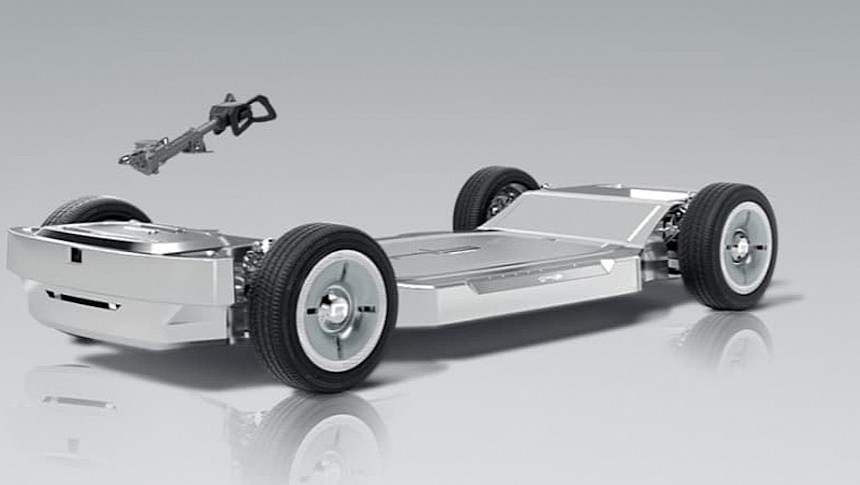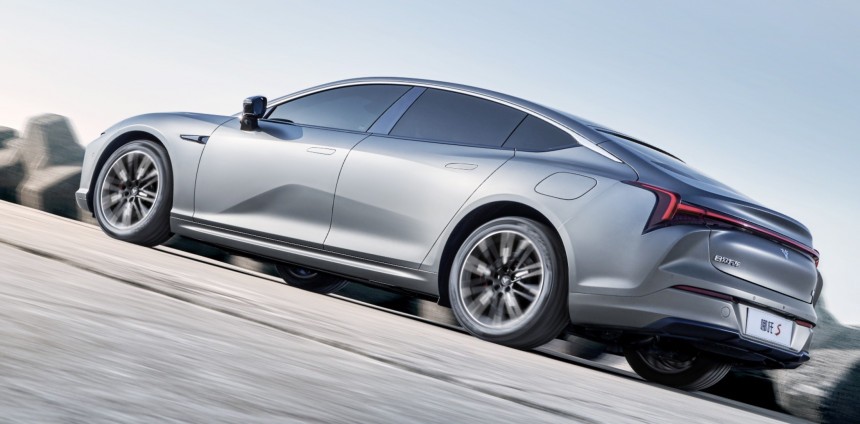Chinese giant CATL is working on a CIIC skateboard chassis. The unit has just completed its first trials in China and achieved a range of over 600 miles.
The car sporting the new technology was tested on was a B-segment compact sedan, most likely a Neta-branded model. It covered 621 miles (1,000 kilometers) with an energy consumption of 10.5 kWh/100 km (10.5 kWh/62 miles). But the figure is achieved in the rather optimistic Chinese testing procedure.
Furthermore, the battery pack was able to charge enough for 186 miles (300 kilometers) in just five minutes using a DC charger.
The CIIC (CATL Integrated Intelligent Chassis) structure integrates the batteries, the electric motors, and other critical units into a single platform that the electric car is built on.
The procedure is specifically designed to bring more efficiency in every direction. It lowers production costs, it reduces the weight of the vehicle, and brings down energy consumption figures. Furthermore, it does not take up much space, which translates into an onboard maximized space for the passengers.
One of the first companies to get involved in the project was EV maker Hozon Auto, which owns the Neta brand. The two companies developed the first CIIC-underpinned model, which is set to be launched in the third quarter of 2024.
The upcoming model has recently completed winter testing in Heihe, northern China, while Turpan was the location for summer testing. That is where the CIIC achieved a range of 621 miles (1,000 kilometers), while the battery pack efficiency was 75%, according to CATL’s Chief Scientist Wu Kai.
In low temperatures, at minus 7 degrees Celsius (19.4 degrees Fahrenheit), the range figures collapsed by 30 percent. The car was reportedly equipped with a 105-kWh battery pack integrated into the floor of the vehicle.
According to CATL, the CIIC integrates a low-voltage and a high-voltage system, as well as steering and braking systems, plus the chassis domain controllers, using CTC (cell-to-chassis) tech.
Car News China reports that, following the launch of the first CIIC-based model, CATL intends to build its own EV.
Neta, the first car brand to receive the new tech, has just opened its first plant outside China, in Thailand. According to the carmaker, more than 12,000 examples of its vehicles were delivered to Thailand, which represents 20 percent of the country’s electric car registrations.
CATL has also signed a memorandum of understanding with VinFast. Therefore, we should expect the new architecture to be adopted by the Vietnamese car brand as well.
Last week, Our Next Energy (ONE) reported about achieving a 608.1-mile range (978.6 kilometers), provided by the Gemini dual-chemistry battery. The car to go that far was a BMW iX with the official range of 391 miles (630 kilometers).
The technology developed by ONE has reached its final development stages. The company will continue to further improve it in order to get it ready for a full production program, with the BMW iX being the first to receive the Gemini battery pack.
Furthermore, the battery pack was able to charge enough for 186 miles (300 kilometers) in just five minutes using a DC charger.
The CIIC (CATL Integrated Intelligent Chassis) structure integrates the batteries, the electric motors, and other critical units into a single platform that the electric car is built on.
The procedure is specifically designed to bring more efficiency in every direction. It lowers production costs, it reduces the weight of the vehicle, and brings down energy consumption figures. Furthermore, it does not take up much space, which translates into an onboard maximized space for the passengers.
One of the first companies to get involved in the project was EV maker Hozon Auto, which owns the Neta brand. The two companies developed the first CIIC-underpinned model, which is set to be launched in the third quarter of 2024.
In low temperatures, at minus 7 degrees Celsius (19.4 degrees Fahrenheit), the range figures collapsed by 30 percent. The car was reportedly equipped with a 105-kWh battery pack integrated into the floor of the vehicle.
According to CATL, the CIIC integrates a low-voltage and a high-voltage system, as well as steering and braking systems, plus the chassis domain controllers, using CTC (cell-to-chassis) tech.
Car News China reports that, following the launch of the first CIIC-based model, CATL intends to build its own EV.
Neta, the first car brand to receive the new tech, has just opened its first plant outside China, in Thailand. According to the carmaker, more than 12,000 examples of its vehicles were delivered to Thailand, which represents 20 percent of the country’s electric car registrations.
CATL has also signed a memorandum of understanding with VinFast. Therefore, we should expect the new architecture to be adopted by the Vietnamese car brand as well.
The race for range
The company is now racing against Toyota. The Japanese carmaker announced that its solid state battery technology will make EVs drive as far as 745 miles (1,199 kilometers) by 2030. The CATL-sourced tech, which brings a range that is not much below what Toyota promises, is supposed to be ready before the end of 2024.Last week, Our Next Energy (ONE) reported about achieving a 608.1-mile range (978.6 kilometers), provided by the Gemini dual-chemistry battery. The car to go that far was a BMW iX with the official range of 391 miles (630 kilometers).
The technology developed by ONE has reached its final development stages. The company will continue to further improve it in order to get it ready for a full production program, with the BMW iX being the first to receive the Gemini battery pack.






